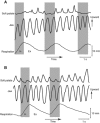Effects of respiration on soft palate movement in feeding
- PMID: 20811071
- PMCID: PMC3318019
- DOI: 10.1177/0022034510377336
Effects of respiration on soft palate movement in feeding
Abstract
Cyclic soft palate elevation is temporally associated with masticatory jaw movement. However, the soft palate is normally lowered during nasal breathing to maintain retropalatal airway patency. We tested the hypothesis that the frequency and amplitude of soft palate elevation associated with mastication would be reduced during inspiration. Movements of radiopaque soft palate markers were recorded by videofluorography while 11 healthy volunteers ate solid foods. Breathing was monitored with plethysmography. Masticatory sequences were divided into processing and stage II transport cycles (food transport to the oropharynx before swallowing). In food processing, palatal elevation was less frequent and its displacement was smaller during inspiration than expiration. In stage II transport, the soft palate was elevated less frequently during inspiration than expiration. These findings suggest that masticatory soft palate movement is diminished during inspiration. The control of breathing appears to have a significant effect on soft palate elevation in mastication.
Figures




Similar articles
-
Food transport and bolus formation during complete feeding sequences on foods of different initial consistency.Dysphagia. 1999 Winter;14(1):31-42. doi: 10.1007/PL00009582. Dysphagia. 1999. PMID: 9828272
-
Coordination of oro-pharyngeal food transport during chewing and respiratory phase.Physiol Behav. 2015 Apr 1;142:52-6. doi: 10.1016/j.physbeh.2015.01.035. Epub 2015 Jan 31. Physiol Behav. 2015. PMID: 25645606
-
Cyclic motion of the soft palate in feeding.J Dent Res. 2005 Jan;84(1):39-42. doi: 10.1177/154405910508400106. J Dent Res. 2005. PMID: 15615873
-
Mastication and swallowing: an overview.Br Dent J. 1992 Oct 10;173(6):197-206. doi: 10.1038/sj.bdj.4808002. Br Dent J. 1992. PMID: 1389633 Review.
-
Properties of tissues surrounding the upper airway.Sleep. 1996 Dec;19(10 Suppl):S170-4. doi: 10.1093/sleep/19.suppl_10.170. Sleep. 1996. PMID: 9085502 Review.
Cited by
-
Higher Masticatory Performance and Higher Number of Chewing Strokes Increase Retronasal Aroma.Front Nutr. 2021 Mar 2;8:623507. doi: 10.3389/fnut.2021.623507. eCollection 2021. Front Nutr. 2021. PMID: 33738295 Free PMC article.
-
Video fluoroscopic techniques for the study of Oral Food Processing.Curr Opin Food Sci. 2016 Jun;9:1-10. doi: 10.1016/j.cofs.2016.03.004. Curr Opin Food Sci. 2016. PMID: 27213138 Free PMC article.
-
Retro-nasal aroma release is correlated with variations in the in-mouth air cavity volume after empty deglutition.PLoS One. 2012;7(7):e41276. doi: 10.1371/journal.pone.0041276. Epub 2012 Jul 17. PLoS One. 2012. PMID: 22815986 Free PMC article.
-
Textural Changes by Mastication and Proper Food Texture for Patients with Oropharyngeal Dysphagia.Nutrients. 2020 May 30;12(6):1613. doi: 10.3390/nu12061613. Nutrients. 2020. PMID: 32486264 Free PMC article. Review.
-
Nasal breathing is superior to oral breathing when performing and undergoing transnasal endoscopy: a randomized trial.Endoscopy. 2023 Mar;55(3):207-216. doi: 10.1055/a-1900-6004. Epub 2022 Jul 14. Endoscopy. 2023. PMID: 35835446 Free PMC article. Clinical Trial.
References
-
- Bailey EF, Fregosi RF. (2004). Coordination of intrinsic and extrinsic tongue muscles during spontaneous breathing in the rat. J Appl Physiol 96:440-449 - PubMed
-
- Fontana GA, Pantaleo T, Bongianni F, Cresci F, Viroli L, Sarago G. (1992). Changes in respiratory activity induced by mastication in humans. J Appl Physiol 72:779-786 - PubMed
-
- Franks HA, Crompton AW, German RZ. (1984). Mechanism of intraoral transport in macaques. Am J Phys Anthropol 65:275-282 - PubMed
-
- Hiiemae KM, Palmer JB. (1999). Food transport and bolus formation during complete feeding sequences on foods of different initial consistency. Dysphagia 14:31-42 - PubMed
Publication types
MeSH terms
Substances
Grants and funding
LinkOut - more resources
Full Text Sources
Research Materials

